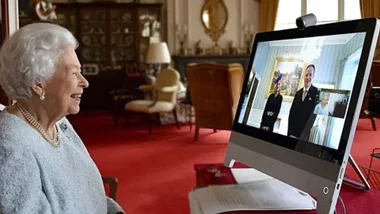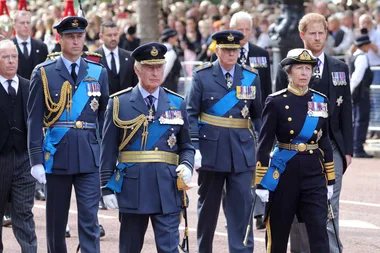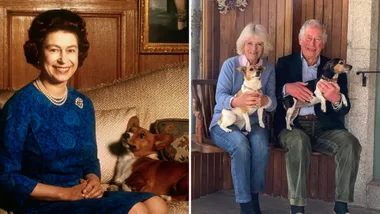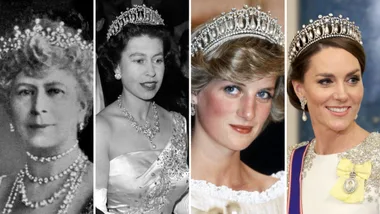When Prince Charles and Princess Diana were expecting their first child in 1982, in the pages of The Weekly’s Royal Baby Special we met the man who would deliver Prince William, Gynaecologist George Pinker.
One day in late June or early July Mr George Pinker’s telephone will ring. It will be the summons to deliver the baby who may one day be monarch of Great Britain.
As surgeon gynaecologist to the Queen and, by custom, to the women in her family, royal babies are no novelty to him. He saw the Duchess of Gloucester’s son and daughters into the world, Princess Michael of Kent’s Frederick and Gabriela, and also Princess Anne’s Peter and Zara.
But this will be his most avidly awaited delivery, the focus of world attention. Photographers will be lying in wait outside his door for the moment when he steps out in answer to that telephone call. Many would find it a paralysing responsibility.
George Pinker, is a kindly, silver-haired man of 57, not tall, something of a dandy in his precise pinstriped suits. His manner treads an admirably fine line between professional authority and affable bonhomie, perfect for the delicate duty of gynaecological adviser to the Queen.
His credentials are impeccable. He is considered one of the top five gynaecologists in Britain and, when he was called upon to succeed Sir John Peel in 1973, he was, at 48, one of the youngest specialists in the royal service. Mr Pinker has been a consultant at St Mary’s Hospital, Paddington, in London, since 1958, and is also consultant gynaecologist at the Middlesex and Soho hospitals, and the King Edward VII Hospital for Officers. For years now he was enjoyed a growing reputation among the more aristocratic young mums who queue in his Harley Street consulting rooms.
Ten years ago, when I was having my first baby, the women with the most well-bred voices and most expensive maternity dresses at the ante-natal classes were all “with Pinker”. Having a baby delivered by Pinker at the Lindo Wing, the private section of St Mary’s Hospital is in the same bracket as sitting in the royal enclosure at Ascot or having tickets for centre court at Wimbledon.
He gave me an ante-natal check-up when my own gynaecologist was on holiday, and his appeal was understandable. I remember him as charming, suave and reassuring without being patronising.
His consultancy at St Mary’s, one of the great London teaching hospitals, means that as well as the rich, the famous, and the high-born, Mr Pinker delivers babies on the National Health Service. Poor and underprivileged mothers from the slum districts around Paddington know him as a wise and gentle doctor, too.
His nursing staff hold him in the highest esteem, always one of the great acid tests. No praise is too good for him.
“He has an immense personal and professional reputation,” said a former administrator at St Mary’s Hospital, describing him as the archetypal gynaecologist — professional, polished and courteous.
This seeming paragon was born in 1924. His father’s name was Ronald; his mother’s, ironically, Queenie. After attending school in Reading, he studied medicine at St Mary’s Hospital and London University, qualifying in 1947. He has worked, in his time, at all the top English gynaecological units, the Radcliffe Infirmary, Oxford, and Queen Charlotte’s Hospital, London, and acquired an international reputation. In 1972, he was appointed honorary consultant obstetrician and gynaecologist to the Royal Women’s Hospital, Melbourne.
Like so many doctors, George Pinker married a nurse, Dorothy Russell. They have four children, three sons and a daughter, all now almost grown-up. Home is a large and comfortable house called Medley in Kingston Hill on the wooded fringes of Richmond Park (his address is no secret; it is listed in the London telephone book). Outside medicine his tastes are simple and civilised — music, an evening at the ballet, gardening, sailing, skiing with his family, fell walking in the Lake District.
Unless complications develop, Mr Pinker will encourage the Princess of Wales to continue to enjoy an active pregnancy with plenty of exercise and sufficient rest. Being the mother of an Heir in direct line to the Throne, Diana will probably be under rather closer medical supervision than other pregnant women of her age, and Dr Richard Bayliss, head of the royal medical household and the Queen’s physician, will be in constant liaison with Mr Pinker.
Princess Anne, as daughter of the Queen, would — in the old royal tradition — have had both her babies at Buckingham Palace. Her own preference was to have them at home, but Mr Pinker was persuasive. He insisted she go into hospital, where all the facilities of modern medicine were available if needed.
Although no formal announcement has been made, many feel the odds are good that the Princess of Wales will also give birth at the Lindo Wing.
Admittedly, crowds can be kept at bay more easily at Buckingham Palace, but the Lindo Wing is approached by a side road that could be sealed off if necessary. Taking the Princess to hospital might be an easier task than taking the hospital to her, which a Palace birth would entail. Blood transfusion units, an emergency operating theatre and staff would all have to be installed.
The maternity section at the Lindo Wing is on the ground floor and, on arrival, the Princess of Wales, like all mothers, would be shown to her room, containing a bed, a telephone on a bedside table, a wash-basin, television, wardrobe, and chairs for visitors.
The “royal” room, the end of a row of nine, nearest the nursery and the shared lavatory, sports a newer wallpaper than the rest. The atmosphere, as a recent patient remarked, remains that of a second-class hotel. There are no private bathrooms and toilets, and the communal baths are Victorian, enormous tubs that require a step-ladder to scale.
The discreet private hotel ambience is helped by the fact that there’s not a white coat in sight. Consultants make their rounds in low-key suits (tweed jackets at weekends), and only don surgical garb for an actual birth. The indication that a birth is imminent is a pair of surgical boots awaiting the gynaecologist outside the door of the room.
As labour progresses, the Princess of Wales will not be transferred to a labour ward. Instead — and this is one of the advantages of the Lindo Wing for royal mothers — nurses convert the high-standing bed into a delivery bed, removing the foot. The paraphernalia of an up-to-the-minute delivery ward is then wheeled in.
Mr Pinker does not merely tolerate the father’s presence: he actively encourages it. “I think it helps the mother very much,” he has said. “I think it strengthen the bond between the parents.”
Captain Mark Phillips was present when both his children were born. So were the Duke of Gloucester and Prince Michael of Kent. With such precedents — certainly if Mr Pinker has any influence in the matter — it is likely Prince Charles will be beside his Diana.
While sympathetic to those mothers wishing to have as natural a birth as possible — he would, for instance, give careful consideration to anyone requesting a Leboyer-style birth — Mr Pinker advocates pain-killers during labour if the mother needs them. Epidural anaesthetics are almost routine for his private patients in the Lindo Wing — Princess Anne had them for the birth of both her children. Although the mother loses sensation below the waist, she remains conscious and alert, and breathing exercises, learned at the ante-natal classes which Mr Pinker heartily recommends, help her participate in the birth.
George Pinker is not the kind of doctor who would rush to initiate anything new and controversial, but nor is he as conservative as his predecessor. He welcomes progress, but he is a careful and sensible man, guided by caution and realism rather than innovation.
He gave, for example, full support to Patrick Steptoe and Dr Robert Edwards when they pioneered the world’s first “test-tube” birth ion 1978, complimenting them on their success. “There is much work to be done for childless couples who have just as much of a problem as many other patients,” he said.
There are, he considers, no ethical problems involved “for the moment”, but “one doesn’t know quite how healthy or otherwise a baby who has been out of the body environment and put back is going to be. There may be problems we can only learn about from experience”. No one knew, he feared, how less-scrupulous people might use the technique.
That blend of receptiveness tempered with circumspection is typical of him. He is the perfect man for the sensitive position he holds, but then, in many respects, he has in the Princess of Wales a perfect patient — young and healthy, looking forward to motherhood, eager to do everything that will be best for her baby. A baby could not have a better production team.











